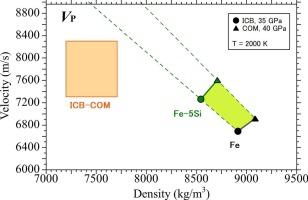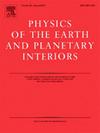高温高压下fcc-Fe和fcc-Fe - si合金的弹性波速和密度
IF 1.9
3区 地球科学
Q2 GEOCHEMISTRY & GEOPHYSICS
引用次数: 0
摘要
假设中等大小的类地行星的固体核心由面心立方(fcc) FeSi合金组成,这使得了解这些材料在极端条件下(高温高压)的弹性特性对于限制行星核心成分至关重要。然而,对fcc-Fe-Si合金弹性性能的研究却很少。我们报告了fcc-Fe和fcc-Fe - 5si (5wt % Si)合金的纵向弹性波速(VP)和密度(ρ)在压力高达15 GPa和温度至1700 K下的综合测量,利用同步原位超声测量,x射线照相和x射线衍射技术。我们的研究结果表明,纯Fe和Fe5Si之间的VP差异在6-8 GPa时最小,但在12-14 GPa时差异显著,表明Si掺入增加了VP的压力依赖性。VP -ρ的线性回归关系产生不同的方程fcc-Fe (VP (m / s) = 1.35(16)×ρ(公斤/立方米)−5.3(14)×103)和fcc-Fe-5Si (VP (m / s) = 2.09(17)×ρ(公斤/立方米)−10.6(13)×103)。关键的是,尽管fcc-Fe-5Si合金的VP与利用地震调查、大地测量学和热传输任务对火星内核的预测非常吻合,但其密度超出了观测限制800-1000 kg/m3。这种差异表明,存在额外的轻元素——可能是氢元素——可以在不实质性改变弹性波速的情况下降低密度,从而为火星核心组成提供了一种新的限制。本文章由计算机程序翻译,如有差异,请以英文原文为准。

Elastic wave velocity and density of fcc-Fe and fcc-Fe–Si alloys at high pressures and temperatures
The solid cores of moderate-sized terrestrial planets are hypothesized to comprise face-centered cubic (fcc) Fe![]() Si alloys, making it essential to understand the elastic properties of these materials under extreme conditions (high temperatures and pressures) for constraining planetary core compositions. However, there are few studies on the elastic properties of fcc-Fe–Si alloys. We report comprehensive measurements of longitudinal elastic wave velocities (VP) and densities (ρ) for fcc-Fe and fcc-Fe–5Si (5 wt% Si) alloys at pressures up to 15 GPa and temperatures to 1700 K, utilizing simultaneous in situ ultrasonic measurements, X-ray radiography, and X-ray diffraction techniques. Our findings reveal that the VP difference between pure Fe and Fe
Si alloys, making it essential to understand the elastic properties of these materials under extreme conditions (high temperatures and pressures) for constraining planetary core compositions. However, there are few studies on the elastic properties of fcc-Fe–Si alloys. We report comprehensive measurements of longitudinal elastic wave velocities (VP) and densities (ρ) for fcc-Fe and fcc-Fe–5Si (5 wt% Si) alloys at pressures up to 15 GPa and temperatures to 1700 K, utilizing simultaneous in situ ultrasonic measurements, X-ray radiography, and X-ray diffraction techniques. Our findings reveal that the VP difference between pure Fe and Fe![]() 5Si was minimal at 6–8 GPa but diverged significantly at 12–14 GPa, demonstrating that Si incorporation increases the pressure dependence of VP. Linear regression of VP–ρ relationships yielded distinct equations for fcc-Fe (VP [m/s] = 1.35(16) × ρ [kg/m3] − 5.3(14) × 103) and fcc-Fe–5Si (VP [m/s] = 2.09(17) × ρ [kg/m3] − 10.6(13) × 103). Critically, although the VP of the fcc-Fe–5Si alloy closely matched Interior Exploration using Seismic Investigations, Geodesy, and Heat Transport mission predictions for the Martian inner core, its density exceeded observational constraints by 800–1000 kg/m3. This discrepancy suggests the presence of additional light elements—potentially H—that could reduce density without substantially modifying elastic wave velocities, providing a novel constraint on Martian core composition.
5Si was minimal at 6–8 GPa but diverged significantly at 12–14 GPa, demonstrating that Si incorporation increases the pressure dependence of VP. Linear regression of VP–ρ relationships yielded distinct equations for fcc-Fe (VP [m/s] = 1.35(16) × ρ [kg/m3] − 5.3(14) × 103) and fcc-Fe–5Si (VP [m/s] = 2.09(17) × ρ [kg/m3] − 10.6(13) × 103). Critically, although the VP of the fcc-Fe–5Si alloy closely matched Interior Exploration using Seismic Investigations, Geodesy, and Heat Transport mission predictions for the Martian inner core, its density exceeded observational constraints by 800–1000 kg/m3. This discrepancy suggests the presence of additional light elements—potentially H—that could reduce density without substantially modifying elastic wave velocities, providing a novel constraint on Martian core composition.
求助全文
通过发布文献求助,成功后即可免费获取论文全文。
去求助
来源期刊

Physics of the Earth and Planetary Interiors
地学天文-地球化学与地球物理
CiteScore
5.00
自引率
4.30%
发文量
78
审稿时长
18.5 weeks
期刊介绍:
Launched in 1968 to fill the need for an international journal in the field of planetary physics, geodesy and geophysics, Physics of the Earth and Planetary Interiors has now grown to become important reading matter for all geophysicists. It is the only journal to be entirely devoted to the physical and chemical processes of planetary interiors.
Original research papers, review articles, short communications and book reviews are all published on a regular basis; and from time to time special issues of the journal are devoted to the publication of the proceedings of symposia and congresses which the editors feel will be of particular interest to the reader.
 求助内容:
求助内容: 应助结果提醒方式:
应助结果提醒方式:


